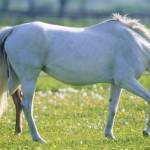Breeding Broodmares After Colic Surgery

Colic can strike at any time in any horse, but certain types of colic occur more frequently in particular breeds or horses used for specific purposes. Broodmares, for example, tend to suffer colic due to large colon volvulus—a full twist of the large intestine that completely cuts off the flow of ingesta, as well as the stream of blood, to that region of the gastrointestinal tract.
A large colon volvulus causes excruciating pain and requires surgery for correction.
“This situation is tricky. Abdominal surgery in a broodmare may save her life, although there are never any guarantees. If she does survive, how will her future breeding career be affected?” questioned Laura Petroski, B.V.M.S., a Kentucky Equine Research veterinarian.
A group of veterinarians* reviewed the medical records from 649 mares with large intestinal volvulus. Of these horses:
- About 90% of mares (584) survived to discharge from the hospital following surgery;
- Of those, 532 (91%) were bred; and
- More than 80% of those (435) broodmares delivered a live foal.
“These data confirm that broodmares can have successful careers even after surgery for large colon volvulus, the most common cause of colic in this population,” summarized Petroski.
Advancing age was an important factor negatively impacting breeding success in this study, as has been reported in other broodmare populations.
While age cannot be manipulated, other factors influencing the health of broodmares could contribute to long, successful careers. Supplementing diets with fish oil, for example, improves a variety of reproductive parameters and benefits the health of the foal. Kentucky Equine Research offers EO-3, a potent marine-derived fish oil containing both DHA and EPA, two important omega-3 fatty acids. This product is top-dressed on feed daily.
*Leahy, E.R., S.J. Holcombe, E.S. Hackett, et al. 2018. Reproductive careers of Thoroughbred broodmares before and after surgical correction of ≥360 degree large colon volvulus. Equine Veterinary Journal 50(2):208-212.








